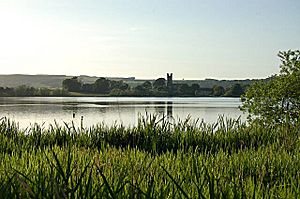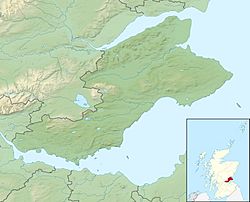Kilconquhar Loch facts for kids
Quick facts for kids Kilconquhar Loch |
|
|---|---|
 |
|
| Location | Scotland |
| Coordinates | 56°12′20″N 2°49′40″W / 56.20556°N 2.82778°W |
| Type | freshwater loch |
| Basin countries | United Kingdom |
Kilconquhar Loch is a freshwater loch (which is the Scottish word for lake) located in Scotland.
This small, shallow loch is very special. It's known as a Site of Special Scientific Interest (SSSI). This means it's a protected area because of its unique plants, animals, or geology. The loch is found next to the village of Kilconquhar in the east of Fife. It's also less than a mile north of the coastal village of Elie.
A Loch with a History
Kilconquhar Loch might not be as old as some other lakes. The first time it was mentioned was in 1599. Back then, it was called "the gret loch callit of auld the Reidmyre." This old Scottish name means "red or reed peat bog."
By 1654, it was called Keanwchar Loch in a famous old map book called Atlas Novus. Scientists have studied the bottom of the loch. Their findings show that it probably started as a bog. There are also old stories and signs that people used to dig for fuel (like peat) here.
How the Loch Stays Fresh
Kilconquhar Loch is a bit of a mystery! It's shaped like a rounded square. What's unusual is that you can't see any rivers or streams flowing into it. Even without a visible inflow, the water doesn't become still or dirty.
Scientists from St. Andrews University are studying the loch. They think that an underground spring might be feeding it. This hidden spring would keep the water fresh and stop it from becoming stagnant.
The loch has ways for water to leave, too. Water drains to the south-east through an underground channel called Loch Run, which goes into Elie harbour. It also drains eastwards into the Inverie Burn.
Wildlife at the Loch
Kilconquhar Loch is an important place for wildlife. In the past, people reported catching large pike and eels here. However, fishing is not allowed anymore because the loch is a protected SSSI.
Many different kinds of wildfowl (like ducks, geese, and swans) use Kilconquhar Loch. They come here to spend the winter months. It's a safe place for them to rest and sleep.
Mapping the Loch
Kilconquhar Loch was part of a big project long ago. Between 1897 and 1909, scientists mapped many freshwater lochs in Scotland. This project was called the Bathymetrical Survey of the Fresh-Water Lochs of Scotland. It was led by famous explorers Sir John Murray and Laurence Pullar.


